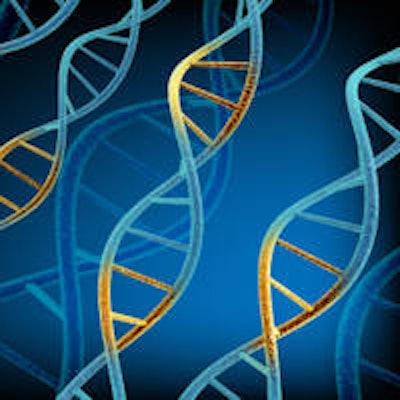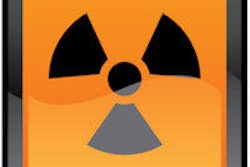
A study published July 22 in JACC: Cardiovascular Imaging is delivering good news and bad news about medical radiation. The bad news: Researchers found measurable evidence of damage to DNA after cardiac CT angiography (CCTA) scans. The good news: There was no sign of damage at radiation levels lower than 7.5 mSv.
Researchers from Stanford University and the Veterans Affairs (VA) Palo Alto Health Care System conducted a prospective study of 67 patients who received CCTA scans over two years. They tracked biomarkers of radiation-induced processes such as DNA damage and programmed cell death in the weeks after the scans, correlating them with the amount of radiation received (JACC Cardiovasc Interv, July 22, 2015).
The patients who were scanned at doses higher than 7.5 mSv demonstrated signs of DNA damage and cell death not found in those who received lower-dose scans, according to lead author Dr. Patricia Nguyen. While the connection between higher doses and DNA changes is concerning, the study offers hope that lower-dose CT techniques have the potential to reduce the cancer risk from CCTA exams.
"We did not detect any damage below 7.5 mSv, which is reassuring and should promote more techniques for developing more ways to use lower dose," Nguyen said. "That is very achievable with current technology."
Risks of radiation
The growing use of cardiac CTA has been raising concerns about the effect of radiation doses on patients, especially given that the radiation burden of CCTA is usually higher than with other types of CT exams. Extensive research has been performed on radiation's effect on cells at therapeutic dose levels, the authors noted, but less is known about what happens at less than 100 mSv, or levels commonly used for imaging applications.
 Dr. Patricia Nguyen of Stanford.
Dr. Patricia Nguyen of Stanford.Therefore, Nguyen, senior author Dr. Joseph Wu, PhD, and colleagues decided to investigate whether CCTA radiation doses caused DNA damage, and whether the extent of damage was associated with the activation of biological pathways used by the body to repair or eliminate cells to minimize mutation risk. Such pathways can include programmed cell death, also known as apoptosis.
The researchers recruited patients older than 18 who underwent clinically indicated CCTA studies at Stanford or the VA Palo Alto Health Care System. They ended up with a patient population of 67 individuals.
Radiation doses to the patients were measured using phantom dosimetry. To track cell damage, blood samples were taken at various time points following the initial CCTA exams, and assay tests such as flow cytometry and immunohistochemistry were used to measure biomarkers of DNA damage and apoptosis.
After the scans, 70% of patients had an increase in phosphorylation of at least one DNA damage marker, the researchers found. The extent of DNA damage was correlated with the level of radiation exposure (r = 0.48, p = 0.0001), and the effect was not seen in patients who received less than 7.5 mSv of radiation.
The researchers then measured levels of apoptotic cell death in a subset of 25 patients. They found that 60% had at least a twofold increase in apoptosis, with a median increase of 3.1-fold. Apoptosis was highest in patients who received CCTA scans with more than 20 mSv of radiation: These patients saw a median 2.3-fold increase in apoptosis, compared with a median 0.7-fold increase in those who received less than 20 mSv.
The researchers also found higher levels of expression of genes responsible for the regulation of apoptosis, cell cycle progression, and cell repair, another indication that DNA had been damaged. But again, increased gene expression was not found in patients who received less than 7.5 mSv of radiation.
What does it all mean?
How should the findings be interpreted? For one thing, Nguyen and Wu are quick to point out that the study does not indicate that CCTA scans are more likely to cause cancer in the patients with more DNA damage.
The body handles DNA damage by repairing damaged cells or using apoptosis to kill them off so they aren't able to cause harm in the future. The cells that end up causing cancer resist both of these processes, but there's no way to tell which cells will mutate into cancer.
"You can't say that low-level radiation causes cancer; that's not proven in the study," Wu said in an interview with AuntMinnie.com. "It just shows that low-level radiation over 7.5 mSv can cause DNA damage."
However, they believe the study findings are significant in that they demonstrate DNA damage not just immediately after a scan, but for some time afterward. And the 7.5-mSv figure is also significant, indicating there could be a threshold below which DNA damage is minimized.
CT dose-reduction techniques have already reduced dose levels below that point for studies outside the heart or for interventional purposes. Further technological advancements are also likely to help.
Indeed, the researchers saw less DNA damage in patients who were scanned using a newer dual-source scanner with prospective gating, compared with those scanned on an older device with retrospective gating.
But the devil is in the details, as the level of radiation required for CT can vary based on factors such as patient body habitus.
"Usually when you have a thicker patient it's hard to use such a low dose, and patients are getting more obese over time," Nguyen said. "We need to continue to advance low-dose techniques."




















